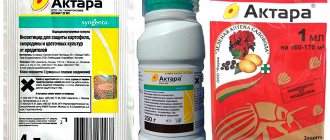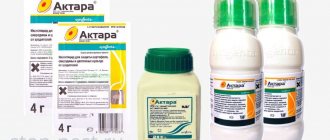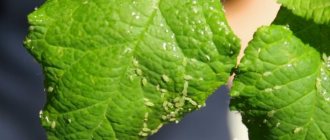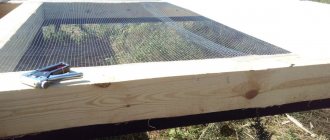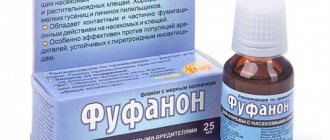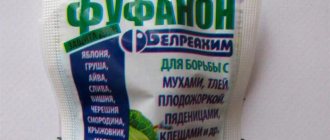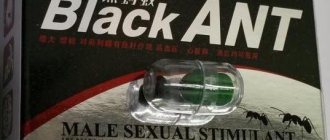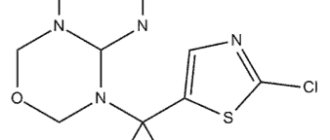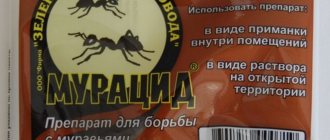Home / Preparations and fertilizers
Back
Published: 06/18/2019
0
3/5 — (3 votes)
Aktara is one of the most popular and widespread insecticides among gardeners and gardeners. A wide range of applications and proven effectiveness against most pests are the undoubted advantages of the drug. Like any chemical, Aktara has limitations that should be considered before use.
- 1 Composition and principle of action
- 2 Scope of application
- 3 Advantages and disadvantages
- 4 Release forms
- 5 Security measures
- 6 How to prepare a solution
- 7 Use for different types of crops
- 8 Processing of seedlings
- 9 Compatibility of Aktar with other drugs
- 10 Actions in case of poisoning
- 11 Reviews
Composition and principle of action
The active ingredient of the drug is thiamethoxam. In small doses, the synthetic compound causes stimulation of the nervous system of pests. Significant concentration leads to paralysis. Aktara belongs to the group of contact-intestinal insecticides. The substance is absorbed into the plant tissue, along with the cell sap enters the gastrointestinal tract of the insect and provokes its death. Pests with thin cover die after contact with the drug. Actara's effect does not apply to eggs, pupae and larvae.
The insecticide is used in 2 ways: spraying the ground parts of garden, vegetable and indoor crops and watering at the roots. In the first case, the solution is absorbed by the shoots in a matter of minutes. When applied to the soil, it takes several hours for the active substance to be distributed throughout all the vascular tissues of the plant. For fruit trees, this time is on average 1-3 days; for low-growing crops, 2-3 hours are enough.
Thiamethoxam mainly accumulates in plant leaves; its concentration in fruits is insignificant. The protective function of the drug lasts for 2-3 weeks after foliar treatment and 2.5-3 months after watering the soil.
Purpose of the product
This insecticide belongs to the group of neonicotinoids and effectively fights the following pests in the garden:
- Colorado potato beetle;
- wireworm;
- thrips;
- aphids;
- psyllid;
- whiteflies;
- leafhoppers;
- flower beetles;
- copperhead;
- spider mite;
- plant mites;
- Diptera miners;
- scale insects;
- false scale insects.
This drug is also capable of suppressing lepidopteran pests, but is not very effective against them.
How to distinguish the original Aktara from a fake
Aktara can be used to treat plants over large areas and in private farms.
Scope of application
The insecticide packaging shows a close-up picture of the Colorado potato beetle, a well-known enemy of potato beds. Despite this, the spectrum of action of the chemical is much wider. Aktara is used in the fight against aphids, whiteflies, thrips, scale insects and many other harmful insects. The effectiveness of protection against onion flies, cabbage flea beetles, and apple moths has been proven. Dangerous pests are controlled in several ways:
- spraying over the entire surface of the above-ground parts of plants;
- application to the soil in beds and in bowls with potted plants;
- soaking the roots of vegetable seedlings;
- treatment of tubers before planting in the ground.
Important points
We all know how delicate violets are and that they have many features. To treat them against pests, you cannot use the spraying method, as this will lead to the falling of leaves and flowers. In this case, it is better to use the watering method.
Regarding another popular and at the same time very capricious orchid flowers, the following should be said. This flower itself requires a lot of attention and care; they are very demanding and sensitive to any changes. But as practice and reviews from those who have already used actara on these delicate flowers show, the drug does no harm at all and can be safely used for treatment.
Advantages and disadvantages
The insecticide is deservedly popular among gardeners. Aktara's strengths include:
- The speed with which the drug affects pests. Insects eat poisoned leaves and receive a lethal dose of a toxic substance, which within half an hour provokes paralysis, subsequently leading to death.
- Effective against a wide group of pests, including insects that parasitize the back side of foliage.
- Absence of the unpleasant odor characteristic of most insecticides in dissolved form. For this reason, Aktar can be used in residential areas to treat indoor plants.
- Weather resistant. Efficiency does not decrease in heat and under the influence of ultraviolet radiation. After absorption, the drug is not washed off by precipitation.
- Safety for humans if precautions are taken.
- Toxic substances are not concentrated in the fruits of treated crops; therefore, hygienic safety is not compromised.
- Compatibility with other drugs aimed at protecting against harmful insects, fungal diseases, stimulating plant growth.
What kind of terrible beast lives in flower pots
And the culprit for all these troubles is a very small living creature with a body length of up to 1 mm, the so-called spider mite, which in fact is not an insect at all, but a member of the diverse family of arachnids - Acari. The main characteristic that distinguishes arachnids from insects is the number of legs. Of course, for an experienced entomologist there are a lot of other signs by which he will always distinguish a spider from an insect, but for the average person, counting the number of pairs of limbs is the easiest way. All insects have three pairs of legs, and arachnids, which include all types of mites, including spider mites, move on four pairs.
If we dig a little deeper into arachnology, the science that studies all arachnids, we learn that mites, and not spiders, are common pests of indoor plants around the world. There are perhaps hundreds of species of ticks, 1270 to be precise, belonging to several families or genera, feeding only on plant foods and weaving a kind of web.
If we conduct a formal study in the conditions of a particular flower pot, we can identify one genus, and another in another pot. But, as a rule, to combat these parasites it is not at all necessary to know exactly which branch of the living world this or that mite belongs to, so in the future it will be enough for us to operate with the general name accepted in biology - spider mite.
Release forms
The development of the drug belongs to the Swiss company Syngenta. In the Russian Federation, Aktara is produced under license. There are several forms of release on sale:
- water-dispersible granules (WDG) packaged in 1.4 g, 4 g and 250 g;
- liquid suspension in ampoules of 1.2 ml and polymer bottles of 9 ml and 1 l.
As a rule, one package of the minimum quantity is enough for processing garden and vegetable beds on individual farms and for use at home to protect indoor flowers. Large packaging is intended for the use of insecticide on an industrial scale.
Stable demand and high cost of Aktara have given rise to a market for counterfeit drugs. To protect yourself from unscrupulous manufacturers, you should know the characteristic features of the original drug:
- the hologram applied to the packaging has a denser structure and is completely separated from the surface;
- the Syngenta logo is visible in the center of the hologram; if you change the viewing angle, the Aktara inscription appears;
- The original packaging contains state registration numbers and container labels (for those licensed in the Russian Federation).
In Russia you can purchase registered analogues of the insecticide, which also contain thiamethoxam: Tiara, Eforia, Doctor Cruiser and Adamant.
The shelf life of granules is 4 years, ampoules - 12 months. The chemical is stored in a sealed condition at a temperature range of 10°C to 35°C, out of the reach of children and pets.
Security measures
Aktara belongs to low-toxic drugs of class 3 hazard for humans and mammals. To completely eliminate the risk of poisoning and burns, you must strictly adhere to the instructions and follow certain technology:
- when working with the substance, use gloves, a mask or a special respirator;
- manipulations with the insecticide are carried out in an open space; when working in a living room, a window is opened;
- refrain from drinking water, food and smoking at the time of contact with the drug;
- after use, burn the container of the used solution;
- After finishing all the work, wash your hands thoroughly and rinse your face.
How to prepare the solution
Aktara is easily soluble in water, but to prepare a working solution from dry granules, some nuances should be taken into account:
- pre-prepare containers for mixing the required volume and check the serviceability of the sprayer;
- the prepared solution cannot be stored, so the required amount of granules is immediately measured, which depends on the crop being treated;
- the contents of the package are diluted in a small amount of water (temperature not lower than 25 °C);
- shake thoroughly until the liquid structure is homogeneous;
- add the solution to the required volume, mix again;
- Liquid Aktara in ampoules is prepared according to a similar principle.
After these manipulations, the drug is ready for use. Plants should be sprayed in cloudy (but not rainy) weather. When the need to treat against a pest does not allow you to hesitate, and there is a likelihood of precipitation, you should spray the plants no later than an hour before the rain. On sunny days, early morning or after sunset is suitable for processing.
Aktara instructions for use, reviews, when to treat fruit trees/plants in the garden
Gardeners know that even if you take care of your garden perfectly, it is still impossible to protect it from pests. You shouldn’t wait for them to appear; it’s better to make sure they don’t happen. Protection against unwanted insects will help solve the problem. We will talk about one of the drugs in our article.
Related article: Karate: instructions for use, reviews, storage of the drug
Sometimes you can hear that Aktaru is called fertilizer. Perhaps this is because the substance can be applied to the soil, just like fertilizer. In fact, the drug has nothing to do with nutrients. It is designed to destroy harmful insects and arachnids. Learn more about what Aktara is, how it affects plants and how to use it in the garden in spring and autumn.
Use for various types of crops
The standard bag contains brief instructions for using Aktara for plant protection. The concentration varies depending on the specific crop and type of treatment.
| Culture | Pest | Drug consumption |
| Potato | Colorado beetle | 1.2 g per 10 liters of water. Spray once. Waiting period 14 days |
| Currant | Aphid | 2 g per 10 liters of water. Spray before flowers appear, re-spray after harvest |
| Tomatoes, eggplants, sweet peppers | Aphids, Colorado potato beetles, whiteflies, leafhoppers | 1.4 g per 10 liters of water. Spray once after an attack by pests 4 g per 10 liters of water for application to the soil |
| Cabbage | Aphids, flies and flea beetles | 3 g per 10 liters of water. One-time spraying. Waiting period 3 weeks |
| cucumbers | Aphids, whiteflies, tobacco thrips | 2 g per 10 liters of water. Spray once until buds appear. 8 g per 10 l for application to the soil |
| Grape | Cicadas | 3 g per 10 liters of water. Single spraying |
| Apple tree | Codling moth, aphid, copperhead | 3 g per 10 liters of water. Spray once before or after flowering. |
| Fruit trees | Aphids, codling moths, honey moths, scale insects | 4 g per 10 liters of water. Spray once before or after flowering. |
| Potted crops | Aphids, scale insects, whiteflies, flies, false scale insects | 1 g per 10 liters of water. Spraying in case of pest attack. 0.8 g per 1 l. Application into the soil after moistening the soil. |
Helpful information! If the bag contains more drug than is required for a single treatment, the granules are poured onto a paper sheet and divided into equal portions using a toothpick. The required amount is used for further preparation. The remaining “piles” are poured into plastic bags with an airtight closure.
Reviews
- Oleg: It is intended to destroy many beetles and aphids. But recently, such a pest as the Colorado potato beetle has already adapted to almost all poisons. So I decided not to use the same one every year. I bought Aktara. Gardeners use it for flowers; it helps save the harvest against Colorado potato beetles and their larvae. I did everything according to the instructions: diluted it, processed it and was immediately surprised by the result. Within 20 minutes, beetles appeared that I had not seen on the bush. I would also advise you to monitor the plants for about 5 days, as new pests may appear and will need to be treated again. I was pleased and recommend it to anyone who still doubts. The only negative that I noticed is the large packaging. A quarter of a pack was enough for me to prepare the solution. But maybe it’s my fault, I purchased 4 g vacuum packaging.
- Olga: my friends gave me a violet for my birthday. I don't know why, but she began to drop flowers, the leaves began to become stained and wrinkled. I didn’t do anything special, I just continued to water the violet. But that was not the case... the leaves were covered with some kind of white coating. Without thinking twice, I simply removed it with a damp cloth. But something didn’t help, and the plaque continued to torment my flower. And when his friends came, they were surprised that this was happening to him. Then I saw some kind of hairy beetle and, without thinking twice, I cut off the entire branch with the beetle. Then I started reading about what kind of pest it was and it turned out that it was a mealybug. After reading how to deal with it, I purchased Aktara. I made the solution right in the room, without going anywhere specially, as described in the instructions. I watered everything according to those instructions. But it’s very interesting that it didn’t help. And all because the poison had no effect on the larvae, and the pest appeared again. I made a more concentrated solution of 1 sachet per 2 liters of water and treated the violet. Honestly, after 2 waterings these beetles disappeared. I was very pleased with the result. Within a month, the flowers began to set again and the leaves were green, without that white coating. And my friends noticed the difference. The flower began to take on a normal appearance. Became more alive. Now I’m thinking of purchasing other species and starting floriculture. With the help of such a tool, I will definitely be able to please everyone with a variety of flowers and their constant blooming. So I recommend stocking up on such a wonderful drug, even if there is no need to immediately use it against pests. He won't bother you.
- Sergey: seems like a normal remedy. But... I won’t say it’s bad. But it works very slowly. I bought my wife a variety of seedlings. She is a gardener who simply cannot live without a dacha. But she was always upset that at least half of it was eaten by some kind of beetle or larva. She has both poisons and sprayers with solutions. But something doesn’t help save the entire harvest. After reading many articles about various means, I also purchased “Aktara” for seedlings. All the reviews were positive and said that there were no downsides. My wife decided to try it. As described, this is a strong pesticide that, when soaking seedlings, affects the entire plant. And when pests try to damage it, it quickly destroys them. They also wrote that it is valid for 60 days. Well, about such a long action, I can bet that the first rain fell and Colorado beetles crawled onto the seedlings. I had to spray it with the solution again. Here I’ll tell you what helped, the beetles disappeared. After treatment, you won’t believe it, the entire crop survived. We couldn't be happier with so many. I advise everyone. Just read the instructions carefully, there is a lot of useful information there. We didn’t find any cons, maybe we just couldn’t get enough of the effect of this product. It is also written that it is good for indoor plants. We want to try it. As soon as we get the result, we will respond immediately.
Processing of seedlings
Aktars are often used to treat potato tubers before planting in open ground and for preventive treatment of seedlings. The procedure is carried out before planting seedlings in a permanent place. The procedure is as follows:
- 1.4 g of Aktar granules are dissolved in 1 liter of warm water;
- seedlings of tomatoes, peppers, eggplant are soaked in the solution for 2 hours so that the roots of the seedlings are evenly wetted with the liquid;
- no later than 12 hours after treatment, the plants are planted in the ground.
To process potato tubers, use 6 g of granules diluted in 0.5 liters of water. The planting material is laid out on polyethylene and sprayed with the resulting solution using a spray bottle. Wet tubers are mixed to evenly distribute the substance and immediately planted in the beds. Potatoes processed in this way are not stored.
Compatibility of Aktar with other drugs
One of the advantages of Aktara is that the drug can be used in combination with most herbicides, pesticides, and growth stimulants. This property allows the insecticide to be used in tank mixtures. Gardeners combine Aktara with Fitosporin M, Epin and Zircon. Before use, it is advisable to conduct a compatibility test of the active ingredients. To do this, mix a small amount of drugs and observe the consistency of the resulting solution. If sediment appears at the bottom, there is no practical point in using the mixture.
Spider mites are a serious pest
Most genera of spider mites can reproduce at an alarming rate. Fortunately, most of them, including the common species, are clearly visible at the moment of greatest activity. That is, at the time when they begin to weave their web. However, some mites, as small as, for example, representatives of the Tarosonemid family, can develop unhindered and cause harm for a significant period of time before their presence is noticed, because not everyone knows what kind of mites there are. By the time their activity is discovered and the plant owner decides on control measures, the infestation can reach very serious proportions.
Actions in case of poisoning
When working with the drug, it is necessary to avoid contact in every possible way with both granules and suspension, and with the working solution. Otherwise, you need to act immediately:
- if drops of the solution get on the skin, they must be thoroughly washed off with a detergent;
- If the chemical gets into your eyes, rinse with cool water for at least 5 minutes;
- If it enters the digestive system, you should take the absorbent and drink plenty of water.
Symptoms of insecticide poisoning include nausea, swelling of the eyelids, and dizziness. In this case, it is recommended to seek medical help.
